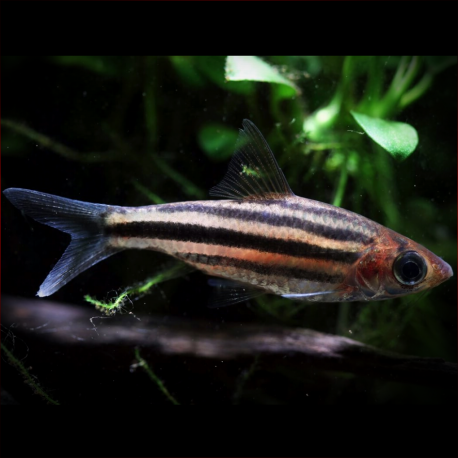More info
Datasheet
| Minimum Tank Size | 240 litres / 63.40 US gallons |
| Maximum Size | 10.0cm / 3.94inches |
| Temperature | 22°C / 71.60°F - 25°C / 77.00°F |
| Hardness | 1.01dgH / 18ppm - 10.03dgH / 179ppm |
| pH | 4.0-7.0 |
General Description
Desmopuntius gemellus, also known as the Twin Barb, is a rarely-traded species within the Cyprinidae family, closely related to D. johorensis and D. trifasciatus. This species is characterized by its vertically-barred juvenile color pattern, which transitions to an adult striped pattern. It can be distinguished by specific physical traits such as the presence of interaxial streaks, dark lateral stripes, and a unique mouth structure. The taxonomy of Desmopuntius underwent reclassification in recent years, leading to the establishment of the genus Desmopuntius to accommodate Southeast Asian cyprinids with distinct color patterns.
Aquarium Setup
For optimal care, a tank of at least 240 litres with soft substrates, dim lighting, roots, branches, and leaf litter is recommended. Desmopuntius gemellus thrives in heavily planted setups or forest stream-type environments with aquatic plants like Microsorum and Cryptocoryne. Water parameters should ideally fall within a pH range of 4.0-7.0, a temperature range of 22-25°C, and a hardness of 18-179 ppm (see table).
Behaviour
Being a schooling fish by nature, D. gemellus thrives in groups of 8-10 individuals. Maintaining them in larger numbers reduces skittish behavior, enhances color displays, and fosters a natural social dynamic within the aquarium. When housed with peaceful Southeast Asian species of similar size, the Twin Barb exhibits harmonious behavior and adds vibrancy to community tanks.
Feeding and Diet
In the wild, Desmopuntius gemellus feeds on diatoms, algae, small insects, worms, and zooplankton. In captivity, they readily consume small live or frozen foods like bloodworms, Daphnia, and Artemia. A balanced diet with high-quality flakes and granules containing plant or algal content is essential to maintain their health and vibrant colors.
Reproduction & Dimorphism
Information regarding the reproduction of D. gemellus is currently unrecorded. Adult males of this species typically exhibit more intense coloration, are slightly smaller, and have a slimmer body compared to females, showcasing mild sexual dimorphism.
Habitat and Distribution
Desmopuntius gemellus inhabits peat swamp forests and blackwater streams in areas with minimal dissolved mineral content and acidic pH levels ranging from 3.0-4.0. This species is indigenous to Sumatra, specifically in the Indragiri and Batang Hari river systems, as well as provinces like Jambi, Riau, and Bangka in Indonesia.

